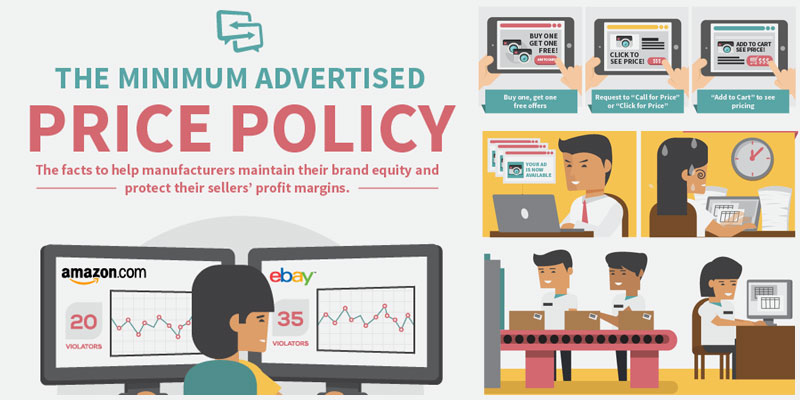The Minimum Advertised Price Policy [Infographic]
Posted on 8th November '16 in MAP Monitoring - Comments

With the dot com boom, the e-commerce industry took off. Anyone and everyone became an online retailer, which meant a heavily saturated and competitive marketplace, where discounting became the norm. Price was the only way to compete.
Because of this shift in the retail landscape, the need for brands to have a minimum advertised price (MAP) policy emerged. A properly enforced MAP policy protects brand equity so brands stay competitive and highly valued in the marketplace, while preserving seller profit margins.
We've put together a helpful infographic to explain the basics of what a MAP Policy is and how MAP Pricing violations can appear.

Infographic Transcription
The Minimum Advertised Price Policy
The facts to help manufactures maintain their brand equity and protect their sellers' profit margins.
Minimum Advertised Price (MAP): The lowest price at which a product can be publicly displayed, without restricting the actual sales price.
MAP Policy: An offer unilaterally enacted by a manufacturer to ensure their seller network does not advertise their products below the minimum advertised price.
Did You Know? In 2007, the Supreme Court made a decision to provide greater legal protection to minimum pricing policies. Learn more about MAP Policy Legality here.
In the growing online world, MAP policies matter more than ever.
They help preserve e-commerce as a viable business model with profitable margins.
- It's quick and easy to sell products online because of less barriers to entry and minimized risk.
- Prevents a 'best-price' self perpetuating feedback loop
- Race-to-the-bottom pricing ultimately erodes a brand's image, value, and integrity.
Common MAP pricing policy violations appear as:
- Buy one, get one free offers
- Request to 'Call for Price' or 'Click for Price'
- 'Add to Cart' to see pricing
But violations are easy to miss because of:
- Ease of selling products online
- Lack of time, tools, and processes to monitor and enforce MAP compliance
Some of the biggest MAP violators are:
- 53% unauthorized retailers (vs. 15% authorized retailers)
- Retailers who have a narrow range of products
- Retailers that charge for shipping (vs. those that have free shipping)
- Unauthorized retailers are the #1 MAP violators
It's important to have a MAP policy and enforcement process in place:
For manufacturers and brands:
- protects brand equity
- maintains product value
- eliminates free riding
- controls downstream prices
- coordinates channel prices
For sellers/dealers/resellers:
- protects profit margins
- prevents price cascading
- focus on service and value
- helps marketing efforts
- drives revenue growth
Did you know? To protect the reputation and legacy of its Ray-Ban sunglasses, parent company Luxottica:
- introduced a MAP policy
- seized 4.8M counterfeit units
- closed 17K+ websites
- removed 375K marketplace listings
To learn more about MAP Monitoring solutions and MAP Monitoring Software to enforce your policy, contact Trade Vitality for a free demo.
- Visit: www.tradevitality.com
- Call: 1-800-801-0536
Sources:
http://www.law360.com/articles/802713/preventing-minimum-advertised-price-policy-violations
http://insight.kellogg.northwestern.edu/article/when-retail-prices-cross-the-line
- http://www.visionmonday.com/latest-news/article/luxottica-launches-efforts-to-protect-rayban-brand-including-new-minimum-advertised-price-map-policy-in-north-america-1/